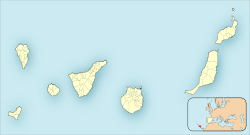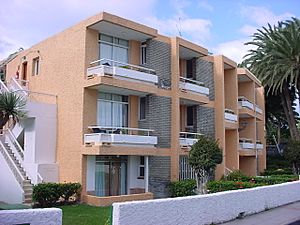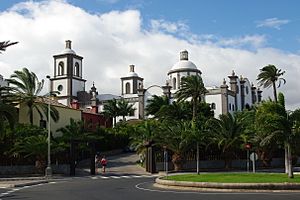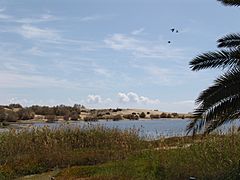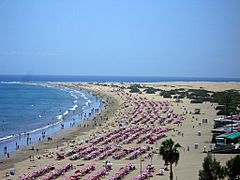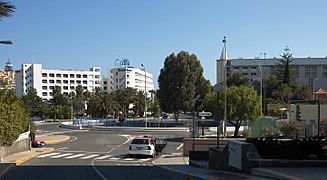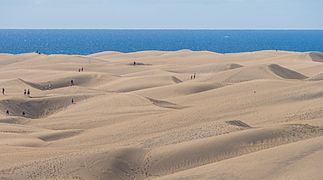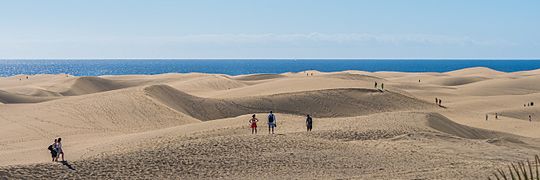Maspalomas facts for kids
Quick facts for kids
Maspalomas
|
|
|---|---|
|
Region
|
|
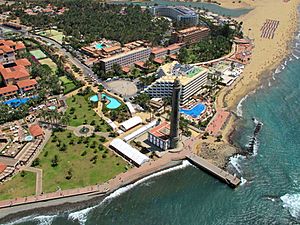
Aerial view of Faro de Maspalomas
|
|
| Country | Spain |
| Autonomous community | Canary Islands |
| Province | Las Palmas |
| Municipality | San Bartolomé de Tirajana |
| Population
(2013)
|
|
| • Total | 36,065 |
| Postal code |
35100
|
Maspalomas is a popular holiday spot on the southern part of Gran Canaria island. This island is one of the Canary Islands in Spain. Maspalomas stretches from Bahía Feliz in the east to Meloneras in the west. It includes other well-known areas like San Agustín, Playa del Inglés, and San Fernando. It's the most southern part of the San Bartolomé de Tirajana area and of the island itself.
Contents
About Maspalomas
Long ago, before it became a big tourist area, Maspalomas was just a small village. This village was located where San Fernando de Maspalomas is today. The name "Maspalomas" might have come from an early settler named Rodrigo Mas de Palomar. Another idea is that it came from Francisco Palomar, a friend of Alonso Fernandez de Lugo.
Today's Maspalomas is a result of a huge building plan. This plan started with a big international competition in 1961. The goal was to develop a large area of land and coastline. A French company called SETAP won the competition. Their ideas helped create a special way of building tourist areas. This model was later used for other holiday spots in the Canary Islands.
Fun for Tourists
Maspalomas is different from many other holiday resorts. It has grown into a full town with many services. It's more like famous places such as Palm Springs in California. You can find many important buildings and services here. These include private clinics and two hospitals. There are also schools for Spanish, English, and Swedish students.
The town has many shopping centers and places for big meetings. You can also find two casinos and several golf courses. There are sports centers and fun theme parks. A Summer University is also held here. It works with the University of Las Palmas de Gran Canaria. This university mainly focuses on topics related to tourism.
Maspalomas offers many places to stay. Most buildings are bungalows, which are spread out, rather than tall high-rise hotels. It's a very popular place for tourists in winter. Many visitors come from northern European countries. These include Sweden, Norway, Finland, Germany, and the Netherlands. It is the biggest tourist spot in the Canary Islands.
Some luxury hotels have been built along the coast. These are between Maspalomas and Meloneras. They have very interesting designs. For example, the Lopesan Villa del Conde hotel looks like a traditional Canarian village. It even has a copy of a large church, which is actually the hotel's reception area.
Maspalomas is also home to Gran Canaria's only English newspaper. This newspaper reaches many readers both in print and online. In 2012, the World Tourism Organization held its World Tourism Day event in Maspalomas. This celebrated 50 years of tourism in the area.
Landmarks and Nature
The most southern point of Maspalomas is called Punta de Maspalomas. Here, you'll see a tall lighthouse. It stands 56 meters (184 feet) high. This lighthouse was finished in 1890. It was built to help guide ships sailing between Europe and the Americas.
The lighthouse looks out over the popular Maspalomas beach. This beach is 12 kilometers (7.5 miles) long. To the east of the lighthouse, you'll find the famous Maspalomas Dunes. These sand dunes stretch all the way to Playa del Inglés. In the 1960s and 70s, new buildings started to affect the dunes. To protect nature, a 4 square kilometer (1.5 square mile) area of dunes was made a nature reserve in 1994.
El Charco is a natural lagoon next to the dunes. Many types of birds come to this lagoon. You can also find eels and small fish called guppies here.
North of Maspalomas, two towns were built for people working in tourism. These are San Fernando and El Tablero. In between them, on a hill, is Sonnenland. This area was built for people from other countries who live there.
You might see large satellite dishes on a hill from Meloneras. This is the Maspalomas Station. It's a special ground station used by the European Space Agency (ESA). It helped with many NASA space missions. These included the Mercury and Gemini Programs. It also supported the Apollo 11 Moon landings and Skylab.
Climate
Maspalomas has a hot desert climate. This means it's usually sunny and dry. It also has some features of a tropical climate. The average temperature is above 18°C (64°F) every month of the year. Winters are very mild and dry. Night temperatures rarely drop below 13°C (55°F). Summers are hot and very dry.
Maspalomas is one of the warmest places in Spain all year round. This is because it's located very far south. The Atlantic Ocean also helps keep the temperatures mild.
| Climate data for Maspalomas C. Insular Turismo (2009-2023), extremes (2009-present) | |||||||||||||
|---|---|---|---|---|---|---|---|---|---|---|---|---|---|
| Month | Jan | Feb | Mar | Apr | May | Jun | Jul | Aug | Sep | Oct | Nov | Dec | Year |
| Record high °C (°F) | 29.3 (84.7) |
29.6 (85.3) |
37.2 (99.0) |
37.3 (99.1) |
39.4 (102.9) |
36.8 (98.2) |
43.6 (110.5) |
45.2 (113.4) |
39.3 (102.7) |
38.1 (100.6) |
32.8 (91.0) |
28.7 (83.7) |
45.2 (113.4) |
| Mean daily maximum °C (°F) | 21.3 (70.3) |
21.6 (70.9) |
22.9 (73.2) |
23.6 (74.5) |
25.2 (77.4) |
26.8 (80.2) |
29.0 (84.2) |
29.9 (85.8) |
28.0 (82.4) |
27.1 (80.8) |
24.7 (76.5) |
22.5 (72.5) |
25.2 (77.4) |
| Daily mean °C (°F) | 18.4 (65.1) |
18.4 (65.1) |
19.5 (67.1) |
20.4 (68.7) |
21.8 (71.2) |
23.4 (74.1) |
25.1 (77.2) |
26.1 (79.0) |
24.9 (76.8) |
24.1 (75.4) |
21.7 (71.1) |
19.8 (67.6) |
22.0 (71.5) |
| Mean daily minimum °C (°F) | 15.5 (59.9) |
15.3 (59.5) |
16.1 (61.0) |
17.1 (62.8) |
18.4 (65.1) |
20.0 (68.0) |
21.3 (70.3) |
22.2 (72.0) |
21.8 (71.2) |
21.0 (69.8) |
18.7 (65.7) |
17.1 (62.8) |
18.7 (65.7) |
| Record low °C (°F) | 12.0 (53.6) |
11.6 (52.9) |
11.1 (52.0) |
14.1 (57.4) |
15.3 (59.5) |
16.9 (62.4) |
19.0 (66.2) |
19.9 (67.8) |
19.7 (67.5) |
17.0 (62.6) |
14.8 (58.6) |
13.7 (56.7) |
11.1 (52.0) |
| Average precipitation mm (inches) | 9.3 (0.37) |
8.3 (0.33) |
6.7 (0.26) |
2.1 (0.08) |
0.4 (0.02) |
0.5 (0.02) |
0.0 (0.0) |
1.1 (0.04) |
10.1 (0.40) |
7.0 (0.28) |
13.1 (0.52) |
14.0 (0.55) |
72.6 (2.87) |
| Source: Agencia Estatal de Meteorologia (AEMET OpenData) | |||||||||||||
Getting Around
Maspalomas has a main bus station called Faro de Maspalomas. It is located near the lighthouse. Bus services connect Maspalomas to other tourist spots and towns in the south. You can also travel to towns along the east coast. Buses also go to the island's capital, Las Palmas.
There have been plans for many years to build a train line. This line, called Tren de Gran Canaria, would connect Maspalomas to Gran Canaria Airport and Las Palmas. A train station is planned near the lighthouse. However, this project has not started yet due to money issues.
Photo gallery
-
The beach of Playa del Inglés
See also
 In Spanish: Maspalomas para niños
In Spanish: Maspalomas para niños


